I was contacted by a game translation hobbyist from Spain (henceforth known as The Translator). He had set his sights on Sierra’s 7-CD Phantasmagoria. This mammoth game was driven by a lot of FMV files and animations that have speech. These require language translation in the form of video subtitling. He’s lucky that he found possibly the one person on the whole internet who has just the right combination of skill, time, and interest to pull this off. And why would I care about helping? I guess I share a certain camaraderie with game hackers. Don’t act so surprised. You know what kind of stuff I like to work on.
The FMV format used in this game is VMD, which makes an appearance in numerous Sierra titles. FFmpeg already supports decoding this format. FFmpeg also supports subtitling video. So, ideally, all that’s necessary to support this goal is to add a muxer for the VMD format which can encode raw video and audio, which the format supports. Implement video compression as extra credit.
The pipeline that I envisioned looks like this:
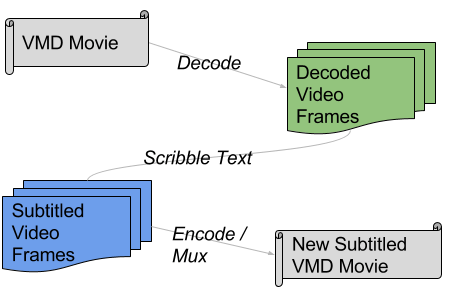
VMD Subtitling Process
“Trivial!” I surmised. I just never learn, do I?
The Plan
So here’s my initial pitch, outlining the work I estimated that I would need to do towards the stated goal:
- Create a new file muxer that produces a syntactically valid VMD file with bogus video and audio data. Make sure it works with both FFmpeg’s playback system as well as the proper Phantasmagoria engine.
- Create a new video encoder that essentially operates in pass-through mode while correctly building a palette.
- Create a new basic encoder for the video frames.
A big unknown for me was exactly how subtitle handling operates in FFmpeg. Thanks to this project, I now know. I was concerned because I was pretty sure that font rendering entails anti-aliasing which bodes poorly for keeping the palette count under 256 unique colors.
Computer Science Puzzle
When pondering how to process the palette, I was excited for the opportunity to exercise actual computer science. FFmpeg converts frames from paletted frames to full RGB frames. Then it needs to convert them back to paletted frames. I had a vague recollection of solving this problem once before when I was experimenting with a new paletted video codec. I seem to recall that I did the palette conversion in a very naive manner. I just used a static 256-element array and processed each RGB pixel of the frame, seeing if the value already occurred in the table (O(n) lookup) and adding it otherwise.
There are more efficient algorithms, however, such as hash tables and trees. Somewhere along the line, FFmpeg helpfully acquired a rarely-used tree data structure, which was perfect for this project.
So I was pretty pleased with this optimization. Too bad this wouldn’t survive to the end of the effort.
Another palette-related challenge was the fact that a group of pictures would be accumulating a new palette but that palette needed to be recorded before the group. Thus, the muxer needed to have extra logic to rewind the file when the video encoder transmitted a palette change.
Video Compression
VMD has a few methods in its compression toolbox. It can use interframe differencing, it has some RLE, or it can code a frame raw. It can also use a custom LZ-like format on top of these. For early prototypes, I elected to leave each frame coded raw. After the concept was proved, I implemented the frame differencing.
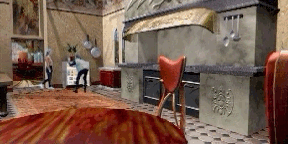
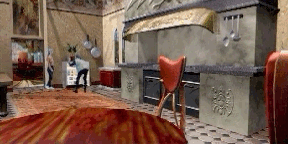
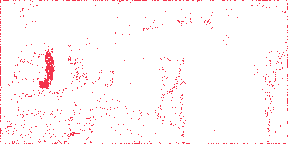
Top frame compared with the middle frame yields the bottom frame: red pixels indicate changes
Encoding only those red dots in between vast runs of unchanged pixels yielded a vast measurable improvement. The next step was to try wiring up FFmpeg’s existing LZ compression facilities to the encoder. This turned out to be implausible since VMD’s LZ variant has nothing to do with anything FFmpeg already provides. Fortunately, the LZ piece is not absolutely required and the frame differencing + RLE provides plenty of compression.
Subtitling
I’ve never done anything, multimedia programming-wise, concerning subtitles. I guess all the entertainment I care about has always been in my native tongue. What a good excuse to program outside of my comfort zone!
First, I needed to know how to access FFmpeg’s subtitling facilities. Fortunately, The Translator did the legwork on this matter so I didn’t have to figure it out.
However, I intuitively had misgivings about this phase. I had heard that the subtitling process performs anti-aliasing. That means that the image would need to be promoted to a higher colorspace for this phase and that the anti-aliasing process would likely push the color count way past 256. Some quick tests revealed this to be the case, as the running color count would leap by several hundred colors as soon as the palette accounting algorithm encountered a subtitle.
So I dug into the subtitle subsystem. I discovered that the subtitle library operates by creating a linked list of subtitle bitmaps that the client app must render. The bitmaps are comprised of 8-bit alpha transparency values that must be composited onto the target frame (i.e., 0 = transparent, 255 = 100% opaque). For example, the letter ‘H’:
(with 00s removed)
13 F8 41 00 00 00 00 68 E4 | 13 F8 41 68 E4
14 FF 44 00 00 00 00 6C EC | 14 FF 44 6C EC
14 FF 44 00 00 00 00 6C EC | 14 FF 44 6C EC
14 FF 44 00 00 00 00 6C EC | 14 FF 44 6C EC
14 FF DC D0 D0 D0 D0 E4 EC | 14 FF DC D0 D0 D0 D0 E4 EC
14 FF 7E 50 50 50 50 9A EC | 14 FF 7E 50 50 50 50 9A EC
14 FF 44 00 00 00 00 6C EC | 14 FF 44 6C EC
14 FF 44 00 00 00 00 6C EC | 14 FF 44 6C EC
14 FF 44 00 00 00 00 6C EC | 14 FF 44 6C EC
11 E0 3B 00 00 00 00 5E CE | 11 E0 3B 5E CE
To get around the color explosion problem, I chose a threshold value and quantized values above and below to 255 and 0, respectively. Further, the process chooses an appropriate color from the existing palette rather than introducing any new colors.
Muxing Matters
In order to force VMD into a general purpose media framework, a lot of special information needs to be passed around. Like many paletted codecs, the palette needs to be transmitted from the file demuxer to the video decoder via some side channel. For re-encoding, this also implies that the palette needs to make the trip from the video encoder to the file muxer. As if this wasn’t enough, individual VMD frames have even more data that needs to be ferried between the muxer and codec levels, including frame change boundaries. FFmpeg provides methods to do these things, but I could not always rely on the systems to relay the data in all cases. I was probably doing something wrong; I accept that. Instead, I just packed all the information at the front of an encoded frame and split it apart in the muxer.
I could not quite figure out how to get the audio and video muxed correctly. As a result, neither FFmpeg nor the Phantasmagoria engine could replay the files correctly.
Plan B
Since I was having so much trouble creating an entirely new VMD file, likely due to numerous unknown bits of the file format, I thought of another angle: re-use the existing VMD file. For this approach, I kept the video encoder and file muxer that I created in the initial phase, but modified the file muxer to emit a special intermediate file. Then, I created a Python tool to repackage the original VMD file using compressed video data in the intermediate file.
For this phase, I also implemented a command line switch for FFmpeg to disable subtitle blending, to make the feature feel like less of an unofficial hack, as though this nonsense would ever have a chance of being incorporated upstream.
At this point, I was seeing some success with the complete, albeit roundabout, subtitling process. I constructed a subtitle file using “Spanish I Learned From Mexican Telenovelas” and the frames turned out fairly readable:
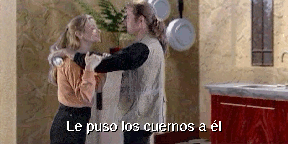
“she cheated on him”
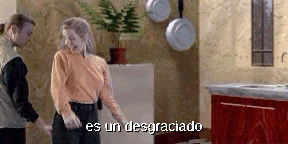
“he’s a scumbag” … these random subtitles could fit surprisingly well!
The few files that I tested appeared to work fine. But then I handed off my work to The Translator and he immediately found a bunch of problems. According to my notes, the problems mostly took the form of flashing, solid color frames. Further, I found tiny, mostly imperceptible flaws in my RLE compressor, usually only detectable by running strict comparison tools; but I wasn’t satisfied.
At this point, I think I attempted to just encode the entire palette at the front of each frame, as allowed by the format, but that did not seem to fix any problems. My notes are not completely clear on this matter (likely because I was still trying to figure out the exact problem), but I think it had to do with FFmpeg inserting extra video frames in order to even out gaps in the video framerate.
Sigh, Plan C
At this point, I was getting tired of trying to force FFmpeg to do this. So I decided to minimize its involvement using lessons learned up to this point.
The next pitch:
- Create a new C program that can open an existing VMD file and output an identical VMD file. I know this sounds easy, but the specific method of copying entails interpreting individual parts of the file and writing those individual parts to the new file. This is in preparation for…
- Import the VMD video decoder functions directly into the program to decode the individual video frames and re-encode them, replacing the video frames as the file is rewritten.
- Wire up the subtitle system. During the adventure to disable subtitle blending, I accidentally learned enough about interfacing to the subtitle library to just invoke it directly.
- Rewrite the RLE method so that it is 100% correct.
Off to work I went. That part about lifting the existing VMD decoder functions out of their libavcodec nest turned out to not be that straightforward. As an alternative, I modified the decoder to dump the raw frames to an intermediate file. In doing so, I think I was able to avoid the issue of the duplicated frames that plagued the previous efforts.
Also, remember how I was really pleased with the palette conversion technique in which I was able to leverage computer science big-O theory? By this stage, I had no reason to convert the paletted video to RGB in the first place; all of the decoding, subtitling and re-encoding operates in the paletted colorspace.
This approach seemed to work pretty well. The final program is subtitle-vmd.c. The process is still a little weird. The modifications in my own FFmpeg fork are necessary to create an intermediate file that the new C tool can operate with.
Next Steps
The Translator has found some assorted bugs and corner cases that still need to be ironed out. Further, for extra credit, I need find the change windows for each frame to improve compression just a little more. I don’t think I will be trying for LZ compression, though.
However, almost as soon as I had this whole system working, The Translator informed me that there is another, different movie format in play in the Phantasmagoria engine called ROBOT, with an extension of RBT. Fortunately, enough of the algorithms have been reverse engineered and re-implemented in ScummVM that I was able to sort out enough details for another subtitling project. That will be the subject of a future post.
See Also:
- Subtitling Sierra RBT Files: The followup in which I discuss how to scribble text on the other animation format
Nice work, though I’d go to the last method directly because I remember fiddling with the VMD demuxer trying to keep up sync and such. Not touching palette is easier too.
Maybe I’d start with original VAG’s code though and use some bitmap font because I’m too lazy to use subtitles. And I still think replacing audio would be simpler ;)
As for .RBT – those are not exactly movies but rather longer animated sprites since they’re supposed to be used inside the actual game scene, not to replace it. Nothing bad will come from documenting that format though.
ScummVM also has a VMD decoder, btw. It also supports more features found in files for other, later games. :P
Also, I wish people would stop calling it Sierra’s format. It’s Coktel Vision’s (and clearly a decendant of their earlier IMD format), and only appeared in Sierra games because Sierra bought Coktel Vision. In fact, my hypothesis (mostly based on conjecture) is still that Sierra bought Coktel Vision solely because of this video format.
@Kostya: I always have to learn the hard way, don’t I? Fortunately, with the RBT side, I started with the angle of replacing video in the existing files rather than trying to rewrite. There are still a lot of unknown parts of that format, so it’s best not to try modifying them.
At first, I thought that The Translator wanted to replace the audio as well. But he insisted he didn’t have the voice talent for that. It probably would have been a lot easier to just swap out the voice samples.
I’ll be writing up the RBT format on the wiki soon.
@DrMcCoy: Interesting. I didn’t know that VMD was acquired. I will have to clarify that when I do some long overdue corrections and cleanup on the VMD wiki page.
Hello Mike, Kostya and DrMcCoy.
As far as i remember, VMD uses reference LZ77 implementation. The only custom feature they added is that tweakable chain length. You can safely ignore it as long as you don’t mind slightly worse compression ratio.
All that complexity with decompression described in the wiki is merely a speed optimization of bitreader and other things.
Sorry, but i’m trying to compile subtitle-vmd.c but have a lot of errors.
Sure that you’re commit the full source files in the branch?
subtitle-vmd.c:71:5: error: unknown type name ‘ASS_Library’
ASS_Library *ass_lib;
^
subtitle-vmd.c:72:5: error: unknown type name ‘ASS_Renderer’
ASS_Renderer *ass_renderer;
^
subtitle-vmd.c:73:5: error: unknown type name ‘ASS_Track’
ASS_Track *ass_track;
^
subtitle-vmd.c: In function ‘subtitle_frame’:
subtitle-vmd.c:215:5: error: unknown type name ‘ASS_Image’
ASS_Image *subtitles;
[…]
@Oscargeek: Thanks for taking an interest in this project. Are you sure that libass development files are installed on the system? Though if this is the case, I would have expected the compiler to complain about missing ass/ass.h include file.
Thanks, the libass was the problem. Now works fine. In the next weekend i’ll see if is viable a spanish translation of the Phantasmagoria’s videos. Thanks mate.